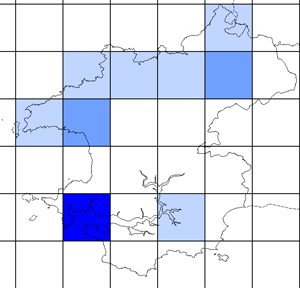Winter visitor and passage migrant. Not recorded from May to July
The Jack Snipe was regarded by Mathew (1894) as a "fairly numerous winter visitor", with occasional flocks of a dozen or more being encountered. Lockley et al. (1949) also considered it "fairly numerous" and added that cold spells brought "great numbers" to Pembrokeshire.
The shooting and ornithological fraternities were much more closely related in those days, which thus ensured a comprehensive coverage of potential Jack Snipe habitat. Birdwatchers today do not habitually tramp across much of the suitable terrain, so the modern record is not so comprehensive. Currently Jack Snipes arrive from 4 September and depart by 26 April, normally one or two being seen at a time in widespread localities, including Skokholm, Skomer, Teifi Marshes and many parts of the Cleddau Estuary, with up to nine having been flushed at the Gann.
Since the second World War there has been a considerable reduction in the kind of habitat favoured by Jack Snipes, so the species is probably less numerous in Pembrokeshire than in the past; certainly there have been no large influxes noted during recent cold spells.
There are two August records from Skokholm, on 18 August 1938 and 20 August 1937.
Donovan J.W. & Rees G.H (1994), Birds of Pembrokeshire
 Wednesday, September 25, 2013 at 5:44PM
Wednesday, September 25, 2013 at 5:44PM  1949 BoP in
1949 BoP in  Jack Snipe
Jack Snipe 


